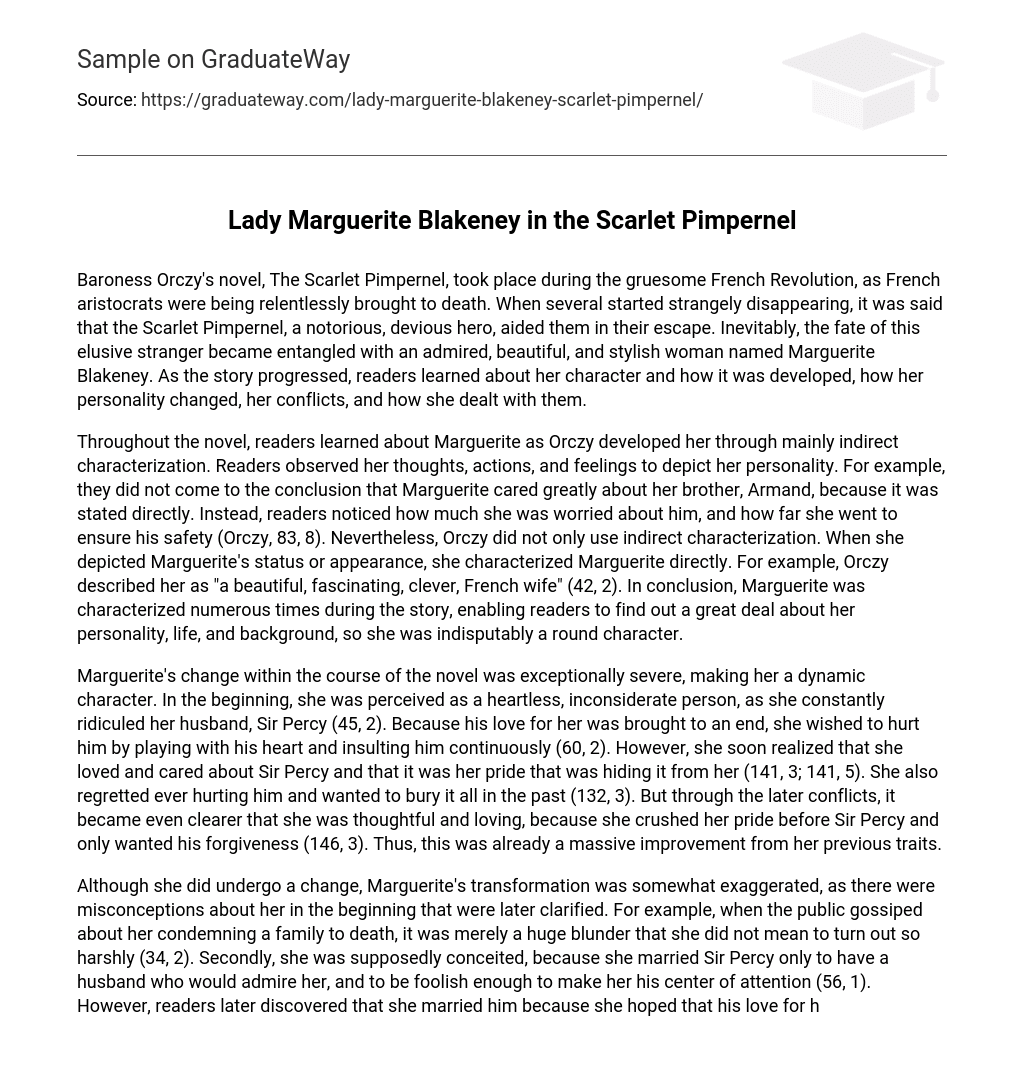Baroness Orczy’s novel, The Scarlet Pimpernel, took place during the gruesome French Revolution, as French aristocrats were being relentlessly brought to death. When several started strangely disappearing, it was said that the Scarlet Pimpernel, a notorious, devious hero, aided them in their escape. Inevitably, the fate of this elusive stranger became entangled with an admired, beautiful, and stylish woman named Marguerite Blakeney. As the story progressed, readers learned about her character and how it was developed, how her personality changed, her conflicts, and how she dealt with them.
Throughout the novel, readers learned about Marguerite as Orczy developed her through mainly indirect characterization. Readers observed her thoughts, actions, and feelings to depict her personality. For example, they did not come to the conclusion that Marguerite cared greatly about her brother, Armand, because it was stated directly. Instead, readers noticed how much she was worried about him, and how far she went to ensure his safety (Orczy, 83, 8). Nevertheless, Orczy did not only use indirect characterization. When she depicted Marguerite’s status or appearance, she characterized Marguerite directly. For example, Orczy described her as “a beautiful, fascinating, clever, French wife” (42, 2). In conclusion, Marguerite was characterized numerous times during the story, enabling readers to find out a great deal about her personality, life, and background, so she was indisputably a round character.
Marguerite’s change within the course of the novel was exceptionally severe, making her a dynamic character. In the beginning, she was perceived as a heartless, inconsiderate person, as she constantly ridiculed her husband, Sir Percy (45, 2). Because his love for her was brought to an end, she wished to hurt him by playing with his heart and insulting him continuously (60, 2). However, she soon realized that she loved and cared about Sir Percy and that it was her pride that was hiding it from her (141, 3; 141, 5). She also regretted ever hurting him and wanted to bury it all in the past (132, 3). But through the later conflicts, it became even clearer that she was thoughtful and loving, because she crushed her pride before Sir Percy and only wanted his forgiveness (146, 3). Thus, this was already a massive improvement from her previous traits.
Although she did undergo a change, Marguerite’s transformation was somewhat exaggerated, as there were misconceptions about her in the beginning that were later clarified. For example, when the public gossiped about her condemning a family to death, it was merely a huge blunder that she did not mean to turn out so harshly (34, 2). Secondly, she was supposedly conceited, because she married Sir Percy only to have a husband who would admire her, and to be foolish enough to make her his center of attention (56, 1). However, readers later discovered that she married him because she hoped that his love for her would instigate a love for him in her heart (132, 5). Thus, readers soon understood that behind every illusion, there was more to the story, and that on the inside, Marguerite was not an immoral person.
In this novel, Marguerite had enormous personal conflicts. Her first one was when her husband neglected her, after a misunderstanding about her sending a family to death. He put on a mask, and became someone completely cold and indifferent (135, 3). This hurt Marguerite greatly, but instead of confronting him, she began to hurt him back (60, 2). This decision was a poor one, and only estranged them further, which demonstrated her poor handling of conflict. Another personal conflict of hers was when an agent named Chauvelin, who was in search of the Scarlet Pimpernel, blackmailed her into helping him find the hero (89, 1). When she first heard of this, Marguerite tried to be very calm and brave, which showed that she took change well (85, 10). However, she was faced with a difficult decision: whether to betray the savior of many, or to give up her brother’s wellbeing (108, 3).
Marguerite, in fright and grief underneath her disguise, ended up following Chauvelin’s orders (114, 6). But when she discovered that her husband was the Scarlet Pimpernel, and that he was in danger of being caught by Chauvelin, Marguerite felt tremendously guilty and worried for him (156, 4). Thus began the overall conflict, in which Marguerite played a small role. Her husband was in imminent peril, but she could not do anything to help him. Although she rushed in attempt to warn Sir Percy that Chauvelin was after him, she did not achieve this goal, and instead watched as he handled the crisis himself (160, 3; 209, 3). Her one action, which was shrieking to alert Sir Percy and Armand to run, did not accomplish anything either (243, 2). Earlier, she was so determined to take action, but in the end, she merely moped about her difficult situation and stepped back, leaving the dilemma to be resolved by other means (159, 5). In summary, Marguerite did not handle conflict well in any way, because she either solved the problem poorly, or did not even solve it.
Since Marguerite did not play a big part in the overall conflict, she was mostly used to narrate the story. Readers viewed the story from the feelings and thoughts in her perspective, making the story narrated in third-person-omniscient, as opposed to third-person-limited or third-person-objective. An example would be how her feelings towards Sir Percy caused readers to respect him, and how her thoughts about Chauvelin influenced readers to fear and hate him. It was also her feelings that gave the story more depth, and made it more lively, suspenseful, and romantic. Orczy’s written language, detailed and equipped with strong verbs that fit the purpose of her writing, additionally added to these, making her novel an enthralling and outstanding read.





